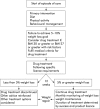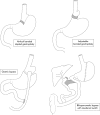New thoughts on managing obesity
- PMID: 15194659
- PMCID: PMC1774129
- DOI: 10.1136/gut.2003.021816
New thoughts on managing obesity
Figures



Similar articles
-
Clinical practice. Nonsurgical management of obesity in adults.N Engl J Med. 2008 May 1;358(18):1941-50. doi: 10.1056/NEJMcp0801652. N Engl J Med. 2008. PMID: 18450605 Review. No abstract available.
-
Weight loss strategies--a change of focus is required.Obes Rev. 2004 Nov;5(4):239-40. doi: 10.1111/j.1467-789X.2004.00155.x. Obes Rev. 2004. PMID: 15458398 Review. No abstract available.
-
Medical management of obesity.Am Fam Physician. 2000 Jul 15;62(2):419-26. Am Fam Physician. 2000. PMID: 10929704 Review.
-
Effects of food form and timing of ingestion on appetite and energy intake in lean young adults and in young adults with obesity.J Am Diet Assoc. 2009 Mar;109(3):430-7. doi: 10.1016/j.jada.2008.11.031. J Am Diet Assoc. 2009. PMID: 19248858 Free PMC article. Clinical Trial.
-
[Principles of nutrition and pharmacotherapy of obesity in patients with obstructive sleep apnea].Pneumonol Alergol Pol. 2007;75 Suppl 1:39-43. Pneumonol Alergol Pol. 2007. PMID: 17440891 Polish. No abstract available.
Cited by
-
Appetite-Suppressing and Satiety-Increasing Bioactive Phytochemicals: A Systematic Review.Nutrients. 2019 Sep 17;11(9):2238. doi: 10.3390/nu11092238. Nutrients. 2019. PMID: 31533291 Free PMC article.
-
Bioactivity-guided isolation and identification of anti-adipogenic compounds from Sanguisorba officinalis.Pharm Biol. 2017 Dec;55(1):2057-2064. doi: 10.1080/13880209.2017.1357736. Pharm Biol. 2017. PMID: 28832233 Free PMC article.
-
Meal Replacement Beverage Twice a Day in Overweight and Obese Adults (MDRC2012-001).Curr Nutr Food Sci. 2012 Nov;8(4):320-329. doi: 10.2174/157340112803832156. Curr Nutr Food Sci. 2012. PMID: 23236298 Free PMC article.
-
Genome-wide mRNA expression analysis of hepatic adaptation to high-fat diets reveals switch from an inflammatory to steatotic transcriptional program.PLoS One. 2009 Aug 14;4(8):e6646. doi: 10.1371/journal.pone.0006646. PLoS One. 2009. PMID: 19680557 Free PMC article.
-
A qualitative study of GPs' views of treating obesity.Br J Gen Pract. 2005 Oct;55(519):750-4. Br J Gen Pract. 2005. PMID: 16212849 Free PMC article.
References
-
- Joint Health Survey (on behalf of the Department of Health). Health Survey for England, 2000. London: The Stationery Office, 2001.
-
- Kopelman PG. Obesity as a medical problem. Nature 2000;404:635–43. - PubMed
-
- Lew EA. Mortality and weight: insured lives and the American Cancer Study. Ann Int Med 1985;103:1024–9. - PubMed
-
- Hubert HB, Feinleib M, McNamara PM, et al. Obesity as an independent risk factor for cardiovascular disease: a 26-year follow-up of participants in the Framingham heart study. Circulation 1983;67:968–77. - PubMed
-
- Reaven GM. Banting Lecture 1988. Role of insulin in human disease. Diabetes 1988;37:1595–607. - PubMed
Publication types
MeSH terms
Substances
LinkOut - more resources
Full Text Sources
Medical
